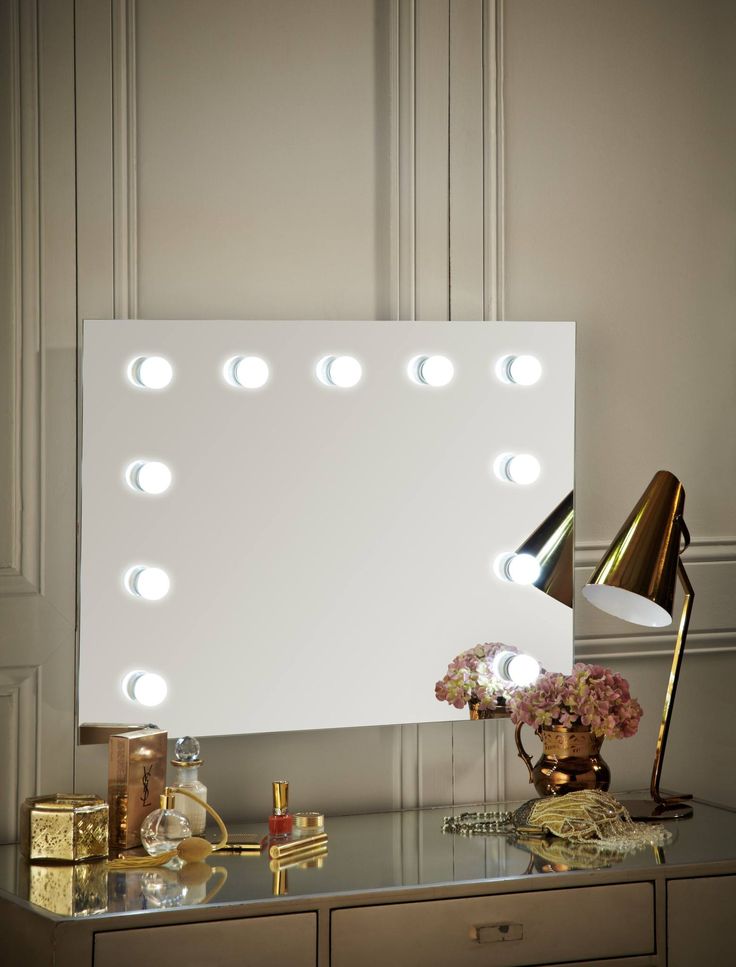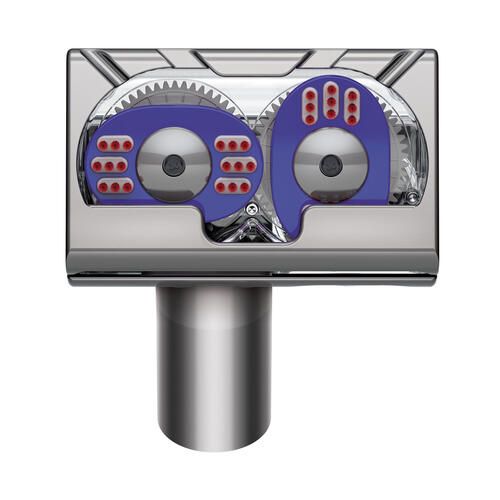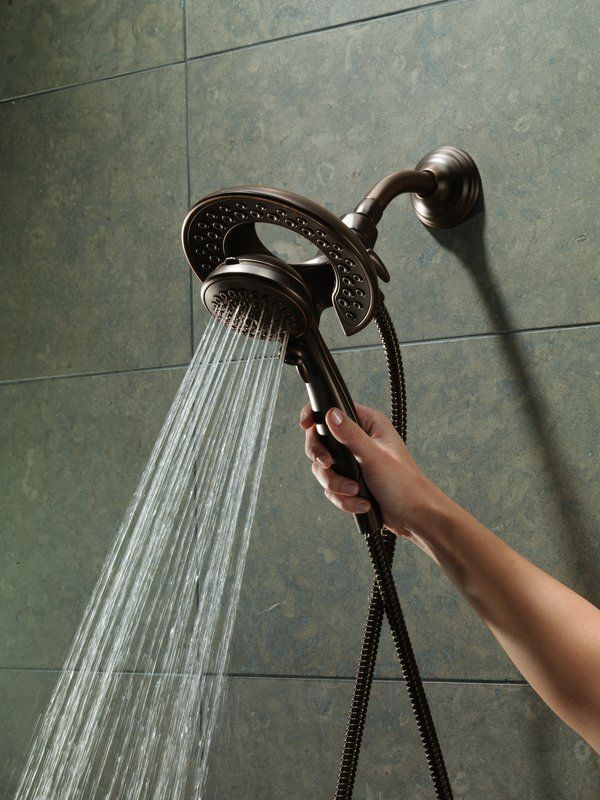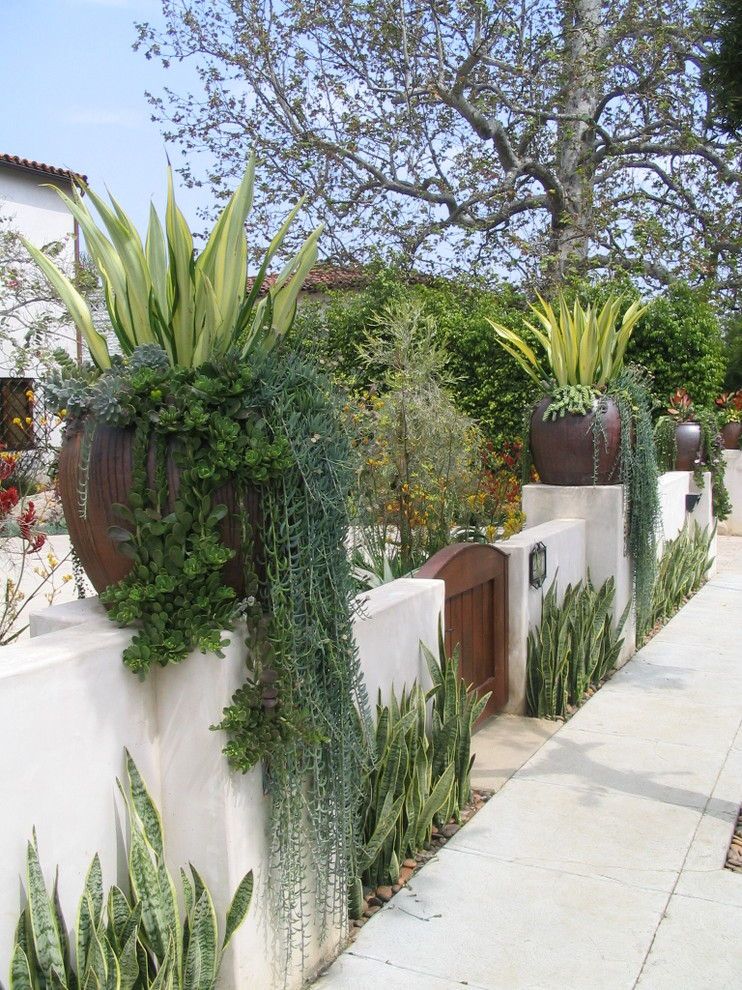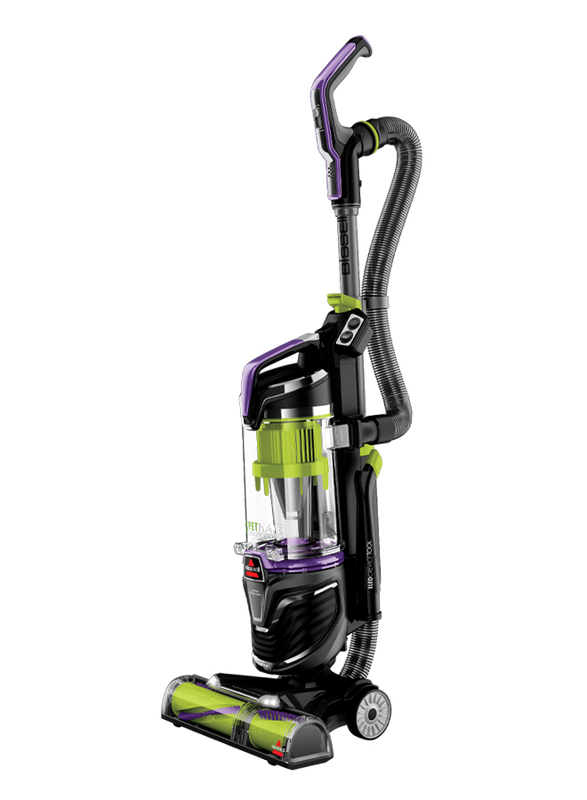Best lighting for mirrors
How to Choose the Best Lighting Fixtures for Bathrooms
When it comes to interior lighting, bathroom lighting is probably given the least consideration of all the rooms in the house. The average client I meet doesn't think to invest there—save it for the living room or kitchen, they say. I see a lot of baths with inadequate mirror or vanity lighting. Often there's just a single ceiling light fixture that's supposed to do it all.
The best lighting for your bathroom helps create a place to relax and recharge. And when it's done right, the payoff is great. After all, this is the room where you start and end your day.
What Type of Lighting is Best for the Bathroom?
A good lighting plan is a series of layers — placing ample light where it is needed for showers, shaving, or putting on makeup, for instance, while other light sources enhance the overall mood of the room.
Task Lighting
Vanity Lighting Fixtures
Vanity lighting gets top consideration because these fixtures work the hardest to illuminate the head and face for grooming. The most common mistake people make is putting recessed ceiling fixtures directly over the mirror. These cast shadows on the face, making daily grooming rituals more difficult.
Vertical fixtures or sconces mounted on either side of the mirror are best for casting an even light across the face.
But given the size and positioning of some vanity mirrors, sidelights can be impractical (mounting them directly to the mirror is always an option, but at greater planning and cost). Only then do I suggest a fixture for over the mirror. It should be placed 75 to 80 inches above the floor and, like all vanity lighting, contain at least 150 watts — ideally spread over a fixture that's at least 24 inches long so that the light will wash evenly over the hair and face.
Shower Lighting
The shower is a secondary area of task lighting. In smaller bathrooms, if the stall has a clear glass door, a dedicated fixture may not be necessary. Otherwise, I recommend a recessed light with a glass lens (plastic will yellow).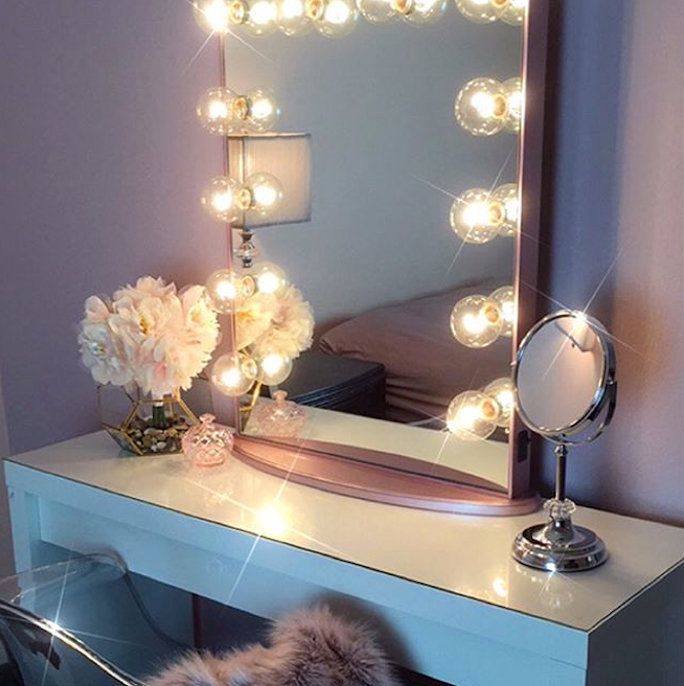 Similar recessed fixtures work well over a freestanding tub or the toilet.
Similar recessed fixtures work well over a freestanding tub or the toilet.
Ambient Lighting
This "fill-in" light serves as a substitute for natural light. It is most often supplied by a central fixture, usually a surface-mounted ceiling light. I encourage clients to think more creatively in their choices, suggesting they consider a pendant lamp or chandelier instead. Another option is "cove lighting" — rope lights hidden behind a molding dropped several inches below ceiling height — which adds a soft glow around the perimeter of the room.
Accent and Recessed LightingA small recessed spotlight directed at a piece of decorative art or a beautiful powder room basin creates another layer of light in the bathroom. Similarly, a recessed shower fixture can be angled (most can be tilted up to 35 degrees at installation) to highlight nice tilework or fixtures and make them sparkle.
Lighting the Vanity RightIan WorpoleTo eliminate shadows under the chin, eyes, and cheeks, fixtures should be mounted on either side of the vanity mirror (or on the mirror's surface, if it's large), 36 to 40 inches apart.
The center of each fixture should be roughly at eye level, or about 66 inches above the floor. This will guarantee even illumination across the face for grooming.
How to Choose the Right Light Bulbs for the BathroomA crisp white light tends to render skin tones most accurately. Halogen bulbs set the gold standard. Low-voltage varieties (with a built-in transformer that converts 120 volts to 12 volts) are especially compact, and the smaller bulb gives a nice sparkling effect.
Halogen bulbs cost a few dollars more than standard incandescents but can last three times as long. Many feature screw-in bases; those labeled medium-base (MB) are shaped like standard incandescents, so they fit most fixtures. The newest compact fluorescent bulbs also offer good color rendering and are up to 10 times more efficient than regular incandescent bulbs.
Include Dimmer LightsThese are a lighting designer's best friend because they grant absolute control over the lighting, and thus the mood, of the room. In a very small space like a powder room, dimming the vanity fixtures might even provide all-in-one task, ambient, and accent lighting. Plus, dimmers conserve energy. The total savings depends on how much you dim the bulb, but one dimmed just 10 percent will last twice as long as a bulb at full brightness.
In a very small space like a powder room, dimming the vanity fixtures might even provide all-in-one task, ambient, and accent lighting. Plus, dimmers conserve energy. The total savings depends on how much you dim the bulb, but one dimmed just 10 percent will last twice as long as a bulb at full brightness.
Today's dimmers work for every kind of light source, though you need to know what to ask for. A 120-volt incandescent or halogen light source will need an incandescent dimmer, while low-voltage and fluorescent fixtures require their own compatible dimmers. Occasionally, dimmed bulbs will buzz as the filament vibrates. Switching to a lower-watt bulb (which has a smaller filament) should reduce or even eliminate the noise.
The Best Bathroom Lighting Puts Safety FirstAttention to aesthetics in the bathroom doesn't diminish the importance of safety. Electricity and water are still lethal companions, and nowhere do they mingle more closely than in the bathroom. Always consult a certified electrician before tackling even the simplest lighting project.
Always consult a certified electrician before tackling even the simplest lighting project.
The National Electric Code requires all new outlets to have GFCIs, ground-fault circuit interrupters; the newer ones can be retrofitted to existing outlets. Even with a GFCI, freestanding plug-in lamps should never be placed near a sink or tub.
Fixtures that are going to be within a certain distance of the tub or shower (usually 6 feet, though local codes vary) must be "wet" or "shower-location" rated. Don't confuse this with the less rigorous "damp-location" rating that's ascribed to most outdoor lighting.
Where to Find ItEaton Single Sconces:
Restoration Hardware
800-762-1005
www.restorationhardware.com
Elongated Sconces, Metro Neo Sconce, and Wall Sconces:
Cassandra Light
Ginger, Fort Mill, SC
803-547-5786
www.gingerco.com
Recessed lighting:
Thomas Lighting
800-825-5844
www. thomaslighting.com
thomaslighting.com
Mirror:
Siria
Design Within Reach
800-944-2233
www.dwr.com
Pendant light:
Mt. Scott by Rejuvenation
888-401-1900
www.rejuvenation.com
Dimmers:
Lutron Electronics Co.
Coppersburg, PA
800-523-9466
www.lutron.com
Our thanks to:
American Lighting Association
Dallas, TX
800-274-4484
www.americanlightingassoc.com
10 rules for side and over mirror lighting |
(Image credit: Future)
Bathroom lighting ideas over mirrors are an integral design element that should be planned at the start of any shower room, wet room or bathroom project.
When it comes to bathroom ideas, whether you like contemporary, traditional or somewhere in between, light fittings are built into the very fabric of the room, providing not only bright, general light over the mirror to help with tasks such as shaving, but also ambient light for mood, which may involve a number of applications.
Here, we focus on the best bathroom lighting ideas over mirrors, and offer expert advice on how you can get the balance of beauty and practicality just right.
Bathroom lighting ideas over mirrors – 10 ways to brighten your space
From overhead lighting with luxe looks to practical bathroom vanity ideas with lighting, and ideas for more decorative bathroom lighting ideas over mirror and vanity units, this advice-packed list will help you find the best options for your room.
1. Install task lighting over a mirror
(Image credit: Rei Moon/Moon Ray Studio)
Task lighting, as you might imagine, provides light for specific tasks. In the bathroom, these could be putting on make-up or shaving so it's likely you'll need task lighting around your bathroom mirror ideas. Installing wall lights either side of the mirror works well, or you could consider a mirror with integrated lighting. Don't position downlighting straight above your head; it'll cast unflattering shadows across your face.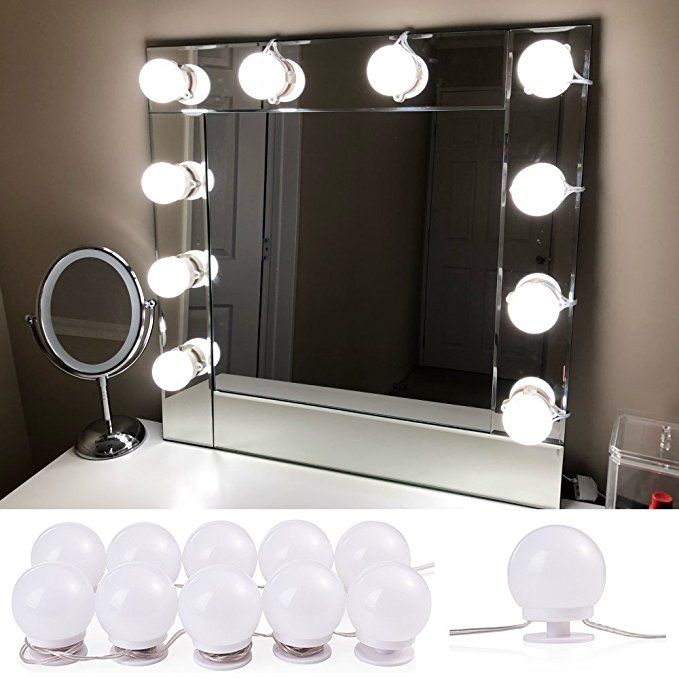
2. Put your bathroom lighting on dimmer switches
(Image credit: James Merrell)
Many of us want a luxury bathroom to be a sanctuary and, ideally, one that is individual to us,' says interior designer Charu Gandhi, founder, Elicyon.
'Functionality is critical to the success of the room and underpins its luxuriousness. Without the practical skeleton in place – from lighting to ventilation – the aesthetics will be diminished.'
'Good lighting also contributes to the luxurious feel of the space. Lighting on different circuits and dimmers can include low-level LEDs under vanity units to provide a soft glow at night, and over mirrors to provide efficient task lighting for night time routines.'
3. Hang wall lights on either side of a mirror
(Image credit: Jon Day)
‘In a small shower room or powder room it is crucial not to underestimate the importance of good lighting,' says Mary Graham and Nicole Salvesen, founders, Salvesen Graham.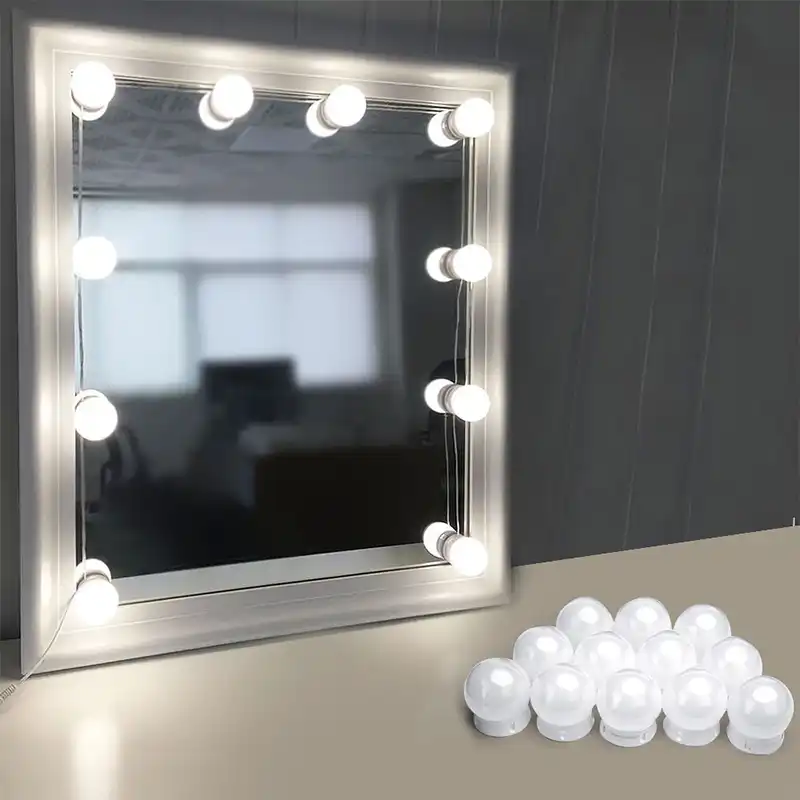 'This should always include decorative wall lights either side of a mirror to provide a softer, more flattering light for the face as well as a decorative feature.’
'This should always include decorative wall lights either side of a mirror to provide a softer, more flattering light for the face as well as a decorative feature.’
4. Use discreet LED lights over a mirror
(Image credit: Anna Stathaki)
Good quality LED bathroom lighting ideas will provide a more attractive quality of light and color rendition - discreet, low glare fittings work best.
The reason they are a great option when it comes to bathroom ideas is because they are easy to integrate into a control system, creating a responsive layered lighting scheme that takes a bathroom from bright on the darkest morning to spa-like relaxation by night.
Employing smart bathroom ceiling lighting ideas over a mirror – and washing the walls with light – gives softer illumination, and can highlight a leading feature, such as a stone wall or statement vanity.
5. Go for symmetry with lighting over a mirror
(Image credit: Future)
Be generous with your bathroom lighting.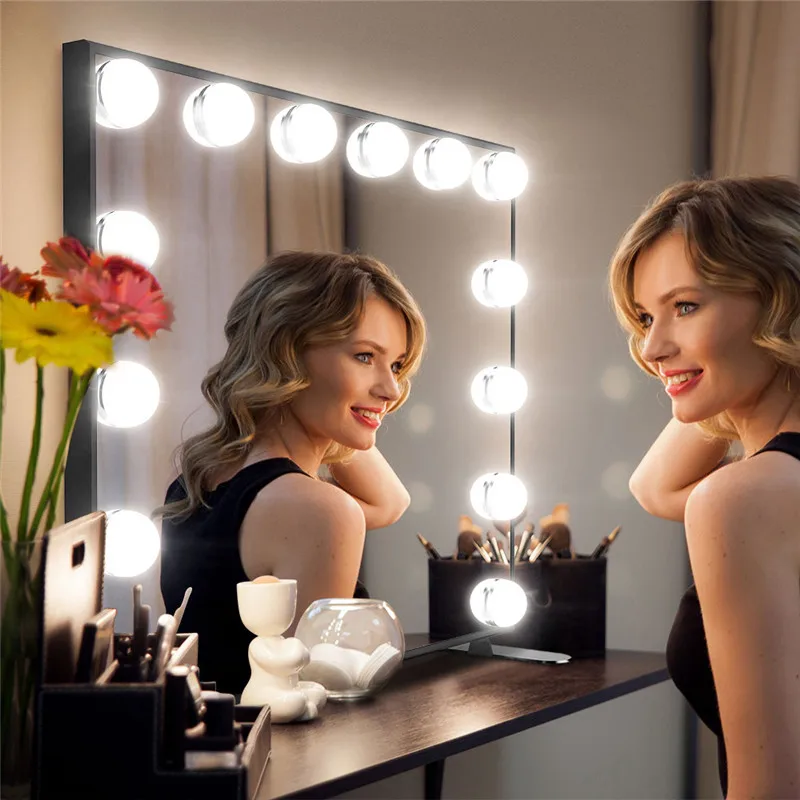 The more sources of light you have, the more moods you can create. A pair of wall lamps and overhead LEDs are a great way to add impact to a vanity unit or statement basin, and will have a bigger visual effect than using only one light source.
The more sources of light you have, the more moods you can create. A pair of wall lamps and overhead LEDs are a great way to add impact to a vanity unit or statement basin, and will have a bigger visual effect than using only one light source.
If you want to create a smart, designed look then go for symmetry – paired lamps at either side of a mirror will frame the design and highlight any architectural elements around them and give a structure to your scheme.
6. Balance functionality with beauty
(Image credit: Future)
Task lighting is generally concentrated around the vanity and mirror. Here, you need bright light but think about installing spots or LEDS in vertical rows down the side of mirrors as opposed to above, to give a more flattering light with less shadows.
In small bathrooms, look at mirrored cabinets with integral lighting as a simple but effective solution.
7. Light up a vanity
(Image credit: Drummonds)
With the correct bathroom lighting trends, your room can take on different looks throughout the day and night.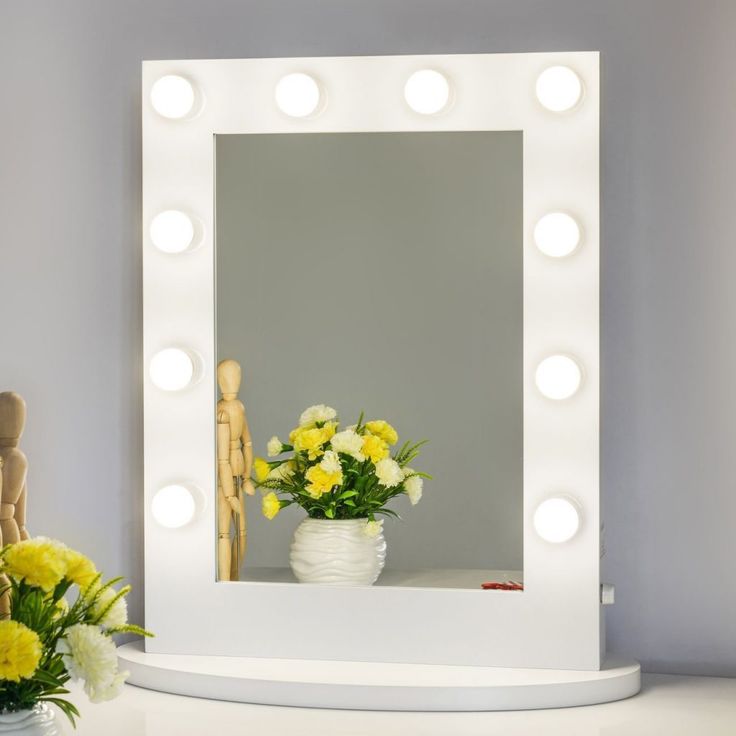
Don’t overlook wall lights when planning your bathroom lighting over mirrors. Downlighters especially have become very popular, with an array of different styles, that are perfect for illuminating your bathroom vanity ideas or for adding interest and ambience to a focal wall.
'It is important to illuminate the mirror and your face with task lighting. A light source on the left and right sides of the mirror, such as two decorative wall lights, will create a shadow-free, flattering light, useful for putting on make-up or shaving,' says Sally Storey of John Cullen Lighting .
8. Use mirrors to amplify light in a bathroom
(Image credit: Davide Lovatti/Future PLC)
Using smart small bathroom ideas can open up the space. A large expanse of mirror will not only help boost size but can amplify light levels, too.
We recommend taking a layered approach to bathroom lighting over a mirror. Use a selection of small ceiling spots, uplighters, downlights and LEDs to create a restful, sophisticated scheme that is both practical and stylish.
(Image credit: Future)
In recent years, bathroom lighting trends have included the use of pendant lighting in the shower and bathroom, often taking the place of traditional wall lights.
Bathroom ceiling lights – in the form of pendants – can create an interesting design feature but it also puts task lighting where it is needed on the countertop of a vanity, brightening skincare rituals and teeth cleaning routines.
10. Consider strip lighting over a mirror
(Image credit: Future)
LED strip lighting at a low level is great at lightening the load in a small space, giving the impression that furniture or even walls are floating.
Chris Jordan of Christopher Wray advises illuminating just above a bathroom mirror with low wattage lighting that reacts to motion sensors.
'This will help you see what you are doing without having to turn on the main lights, which can be difficult for your eyes to adjust to and may inhibit your ability to return to sleep.
'Motion sensors are particularly handy in the middle of the night and in the morning too,’ he adds.
Should bathroom lights hang over a mirror?
The short answer is yes, you should fix bathroom lights over – or, on either side – of a mirror if you are planning efficient task lighting in a bathroom, powder room or shower room.
Lights fixed on both sides of a bathroom wall mirror cast an even light across the face, ideal for applying makeup or shaving, while the mirror itself provides a reflective surface which also amplifies a spacious feel.
As with all bathroom lighting ideas over a mirror, for safety reasons it is important to use waterproof fittings that are specified as suitable for bathroom use – and use a licensed (qualified) electrician to carry out the installation work.
Jennifer is the Digital Editor at Homes & Gardens. Having worked in the interiors industry for a number of years, spanning many publications, she now hones her digital prowess on the 'best interiors website' in the world. Multi-skilled, Jennifer has worked in PR and marketing, and the occasional dabble in the social media, commercial and e-commerce space. Over the years, she has written about every area of the home, from compiling design houses from some of the best interior designers in the world to sourcing celebrity homes, reviewing appliances and even the odd news story or two.
Multi-skilled, Jennifer has worked in PR and marketing, and the occasional dabble in the social media, commercial and e-commerce space. Over the years, she has written about every area of the home, from compiling design houses from some of the best interior designers in the world to sourcing celebrity homes, reviewing appliances and even the odd news story or two.
Creating the right mirror lighting
2020-03-25
Almost no room in the house can do without a mirror: it is an indispensable attribute of the bathroom and dressing room, it can be found in the living room, bedroom and in most other rooms. And in order for the mirror to be not only beautiful, but also a functional piece of furniture, it needs additional lighting.
Mirror lighting has two main functions in the interior: practical and decorative.
- The first involves the creation of high-quality lighting, clearly and correctly conveying colors and other parameters of reflecting objects.

- The second is limited to creating a certain mood and atmosphere in the room.
If you need additional light at the mirror to make it comfortable to perform cosmetic and hygiene procedures (shave, apply makeup, etc.) or pick up clothes without fear of distorting the real "state of things", then you need to pay more attention to technical characteristics lighting sources.
If the lighting is only part of a harmonious and stylish interior, it is worth first of all to study the aesthetic side of the issue.
The first and main requirement for light, regardless of the purpose of the backlight, is its quality. The light should not “dazzle” and be too harsh. From such lighting, the eyes will quickly get tired, and the reflection in the mirror will seem blurry. To avoid the problem of excessive sharpness, choose light sources with frosted diffusers.
Another important parameter is color temperature. The range of light emission includes cool, neutral white and dark tones. Light from the cold part of the spectrum distorts colors, giving the face a pale and unhealthy tone. Warm light gives a more realistic picture, but can also create unwanted effects.
Light from the cold part of the spectrum distorts colors, giving the face a pale and unhealthy tone. Warm light gives a more realistic picture, but can also create unwanted effects.
Ideal for mirror lighting are sources that give a neutral light, close to natural sunlight (they have a color temperature in the region of 4000 Kelvin).
To illuminate the area around the mirror, the following lighting fixtures are usually used:
- wall sconces;
- universal fixtures;
- point (spot) systems.
Sconces are elegant, aesthetic and functional light sources. They are distinguished by a huge number of design solutions, as well as convenience and ease of use. To illuminate the mirror, it is better to choose models with shades of frosted or white glass - they scatter light better.
Universal lighting fixtures are also available in many design and mounting options. Their big plus is that they illuminate not only the area next to the mirror, but also part of the space around it - there are practically no shaded areas, which means that the reflection is not distorted.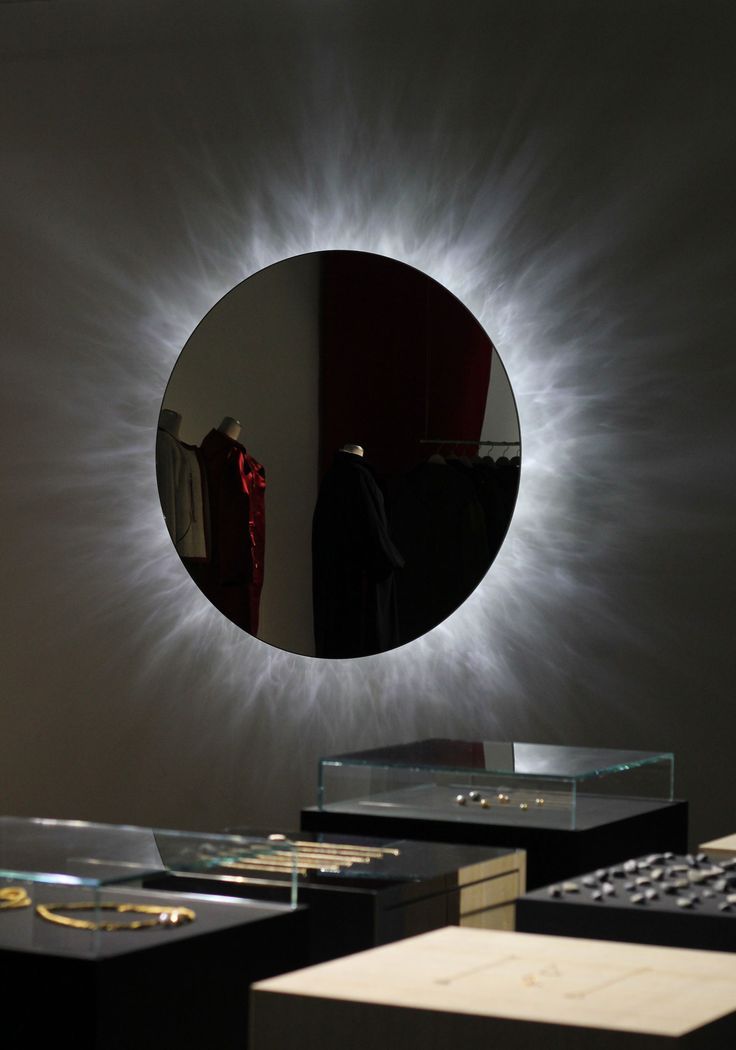
Spotlights can be fixed or placed on movable brackets. The second option is preferable in terms of ease of use: the light can be adjusted for each family member separately. Spots should not be directed directly into the mirror, they should be placed at some distance from the reflective surface, so that they are not visible in it.
For bathrooms and other rooms with high humidity, you should select models of fixtures with a high degree of dust and moisture protection. This indicator can be found from the marking of the device, it starts with two letters IP, followed by two digits. The optimal level of protection for rooms with an unfavorable "microclimate" is IP44-IP67.
The most logical and convenient way to arrange the lamps is symmetrically along the sides of the mirror. The optimal distance between light sources is 60-70 cm, the optimal distance from the floor is 120-150 cm. With this placement, the light will evenly “fall” on the face and figure, and the reflection in the mirror will not be distorted.
Another placement is above and below the mirror. It is not preferred, since the light sources in this case create a "tunnel" effect and somewhat distort the colors and parameters of the reflected objects. It makes sense to place one pendant lamp above the mirror as an addition to side light sources in a spacious room with high ceilings.
A completely impractical and inappropriate way to place lighting fixtures - only on one side of the mirror (it doesn't matter: on the side, below or above). With this arrangement of devices, part of the reflection will be “in the shade”, part will be “blurred”, and the backlight itself will not only focus on the existing flaws, but also add imaginary ones.
Versatile and practical option for any interior - a mirror with built-in lighting. It is mounted on the reverse side of the reflective surface and can be located around the entire perimeter of the product, on its sides or above and below.
The most popular type of light sources are neutral glow LEDs. They give good light quality, do not heat up, save energy and have a long service life. In addition, the correct white glow emanating from the mirror helps to visually expand the space and add lightness.
They give good light quality, do not heat up, save energy and have a long service life. In addition, the correct white glow emanating from the mirror helps to visually expand the space and add lightness.
Sometimes manufacturers complete ready-made models with cheap diodes and light bulbs. Their characteristics do not allow creating really high-quality lighting. It is rarely possible to check these parameters according to the documentation - they are simply not indicated there. For this reason, you need to carefully and meticulously choose a mirror with backlight in the store, it is better not to save on such a purchase so as not to experience disappointment from it in the future.
Modern models have touch control of the light, they allow you to adjust the brightness of the lighting, set the automatic backlight off, display useful information (temperature, humidity, etc.) on the display built into the reflective surface, and have many other interesting options.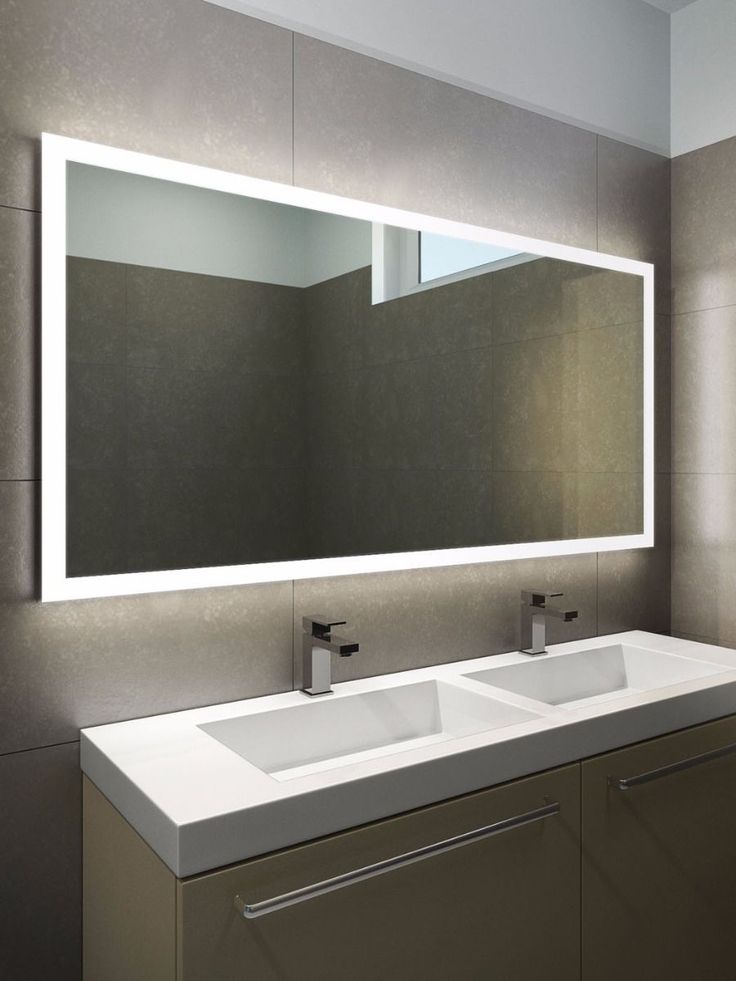 They have one drawback - a rather high cost. Before buying such a product, you need to check the touch mechanism, it should respond well and quickly to touch.
They have one drawback - a rather high cost. Before buying such a product, you need to check the touch mechanism, it should respond well and quickly to touch.
An interesting solution can be models with a transparent illuminated pattern around the perimeter or models with colored illumination. These types of mirrors are more suitable for decorating a room, as their specific lighting can distort reflective objects.
Illuminated mirror is a versatile item. It objectively and realistically reflects the surrounding space and in itself is a real decoration of the interior. In order for such a mirror to successfully cope with the functions assigned to it, you need to carefully and thoroughly approach the issue of choosing and acquiring it.
Choosing bathroom fixtures
The right lighting for bathroom mirrors and other rooms: expert advice
The wrong light distorts not only the sense of space and the scale of the furniture. He literally mocks ordinary people - he focuses on flaws that are not significant and not noticeable in natural light. Bad light is so important that we can be upset by our own reflection in the mirror. But as soon as you properly organize the lighting, you will begin to see your realistic image, without the grotesque. And most likely, you will love your appearance in the mirror again. Try it!
Bad light is so important that we can be upset by our own reflection in the mirror. But as soon as you properly organize the lighting, you will begin to see your realistic image, without the grotesque. And most likely, you will love your appearance in the mirror again. Try it!
Designed by Ekaterina Kolegova Ecole
Nash Baker Architects
Here and now
It only seems that the mirror reflects reality. In fact, this is not so - the mirror reflects a specific moment, a moment of this reality. And we, peering into the reflection, think that this is how others see us.
It's one thing - an illuminated cosmetic mirror that allows you to see and mask flaws or emphasize the dignity of the face. Another is a mirror in the hallway. In the morning, before leaving the house, you observe yourself in the large mirror of the hallway: are you dressed correctly, are your shoes appropriate for the season, do not take an umbrella (and will it be combined), what gloves are suitable, and so on.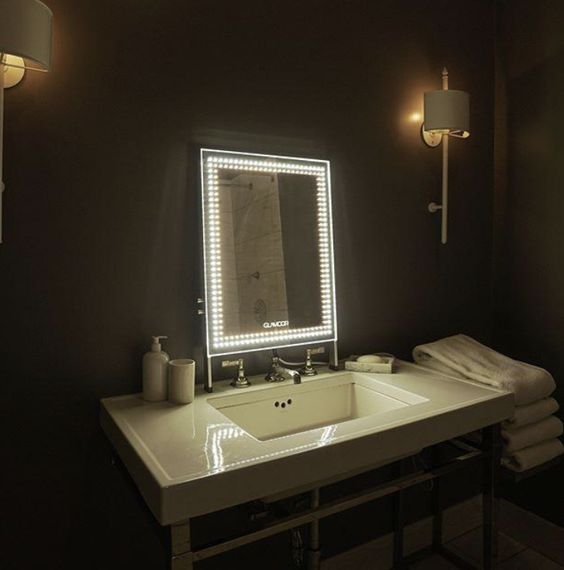 But the main problem is that the mirror in the hallway shows us as we are in the hallway - as soon as we leave the room, our appearance will change.
But the main problem is that the mirror in the hallway shows us as we are in the hallway - as soon as we leave the room, our appearance will change.
No, we will be wearing the same set of clothes, but we will look different. And the whole difficulty is that the light will change. You have one source of light in the hallway, and others on the street, third in offices and offices, and fourth in theaters. Therefore, the first and only rule is that if you want to see your real reflection, then arrange at the mirror (in the hallway, at the illuminated dressing mirror) lighting close to where you are going.
Nina Frolova
Metro effect
It's no secret that people in the subway look tired at eight in the morning, at noon, and in the evening. But the eternal fatigue of the townspeople is only partly true. The whole truth is that the lighting of the cars makes everyone seem a little lifeless. The weak and unevenly distributed light of subway cars leaves shadows of nasolabial folds on the face and creates ugly blackouts under the eyes - it emphasizes protruding areas, such as the nose or brow ridges, which makes even the most even and young face look like a person drowned kittens, and men have brow ridges more developed than women (such are the features of the human skeleton), so they also look gloomy and angry in the subway.
Barlow & Barlow Design
1. No to directional light
Directional incident light disfigures a person, and if it is the light from a halogen lamp, the effect of intimidation is doubled. The fact is that halogen lamps, in addition to adding unnecessary underlined shadows, also change colors (making them warm).
It's easy to check this in practice - go to the fitting room of the store. In every second you will see halogen lamps, and in every second you will not like the clothes. It would seem that in fitting rooms, on the contrary, they should do everything so that a person buys clothes of this brand, so that he likes himself. But no, alas - in every second store I encounter a similar error. And I just don't waste my time going to the fitting room if it has a directional downward halogen light. Why, if I know: any wonderful thing will look bad in this light. Emphasizes all the flaws that are already there, and adds those that are not.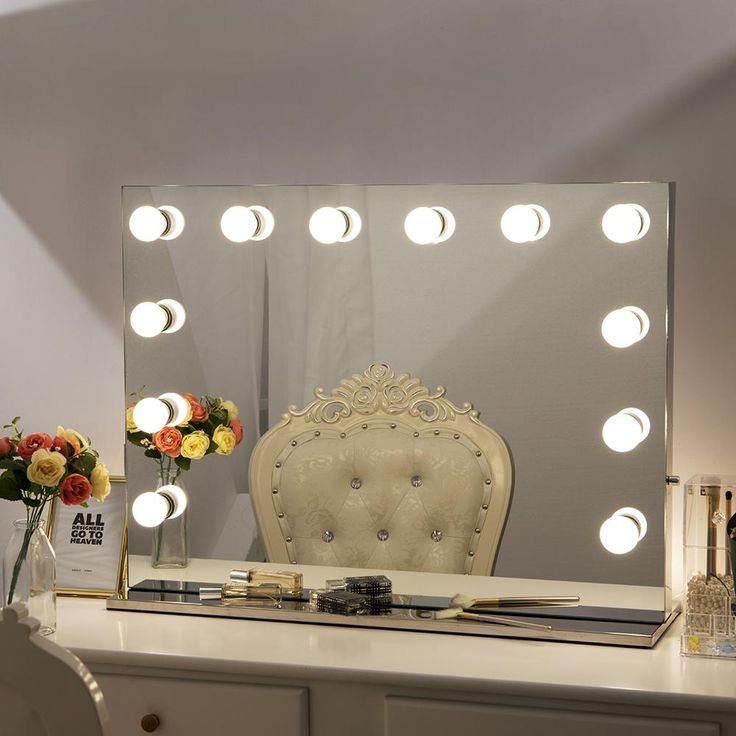
READ ALSO…
Wonder of the World: Colored and colored light in the interior
Nina Frolova
Diffused light is closest to the sun and at the same time skillfully hides our shortcomings. Reflecting from the surface, sunlight evenly illuminates it: it emphasizes the advantages and hides the flaws. Sunlight is recognized as the measure and standard of illumination, it is daylight that is the most truthful.
Does this mean that office lighting, known as "fluorescent lights", is capable of giving a realistic display? No. It has nothing to do with the light of the sun (unless, if you close your eyes and imagine that it is bees buzzing in a sunny meadow, and not the lamp itself). The light of fluorescent lamps is cold and flickering, it makes the colors gloomy, taking them into a blue haze. People's faces are losing their color. In no case do not use such a light at home, and even more so do not illuminate a mirror with it.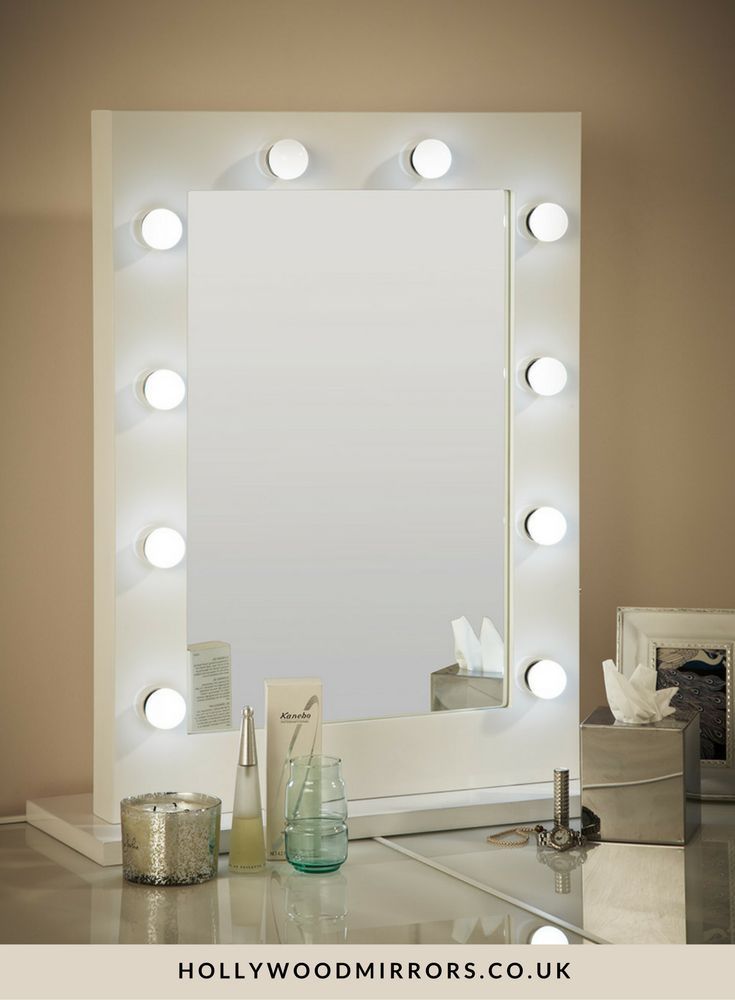
Ruslan Kirnichansky
How to achieve perfect lighting
You have to look up to the sunlight. Of all the possible lighting options, LED bulbs are the closest to sunlight in a shade of neutral white, but they need competent support from other light sources. Possible lighting options at the mirror.
- Between the person and the mirror on the ceiling there is a diffusing LED light source (neutral white), on the same axis, behind the person's back, there is a diffusing LED light source (milky shade).
Important: Light sources must not be reflected in the mirror together with the person, otherwise light distortion will occur.
Ruslan Kirnichansky
- Use one directional lamp, but the bulbs should be of different shades (neutral and milky). And the spots should be directed to adjacent walls, and not to the mirror.
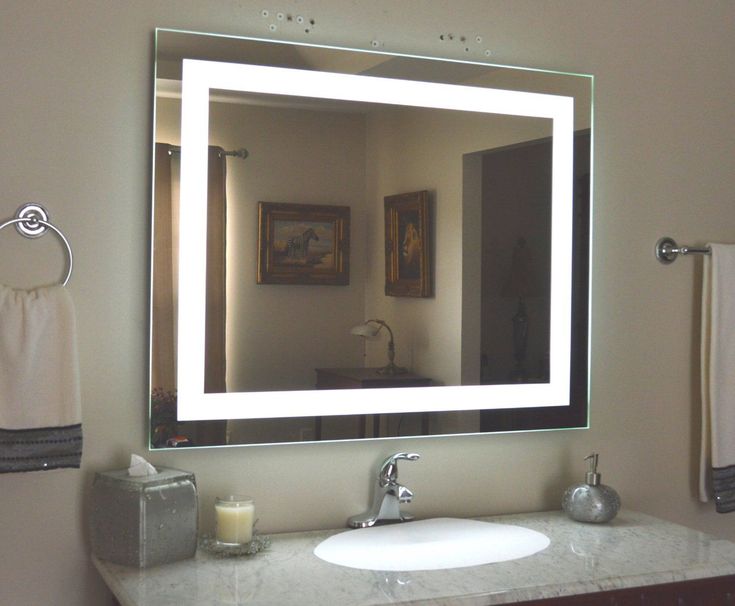 Neutral lighting should be added above the mirror itself. It can be matte light bulbs or an LED filament directed at a mirror, as a backlight for paintings. The light reflected from the walls will create soft shadows, and the light directed at the mirror will form an accent on the face.
Neutral lighting should be added above the mirror itself. It can be matte light bulbs or an LED filament directed at a mirror, as a backlight for paintings. The light reflected from the walls will create soft shadows, and the light directed at the mirror will form an accent on the face.
Ruslan Kirnichansky
- There are special lamps for mirrors, which are similar to dressing room lighting. This is a rail that has a few paws on it and is mounted next to the mirror, but it's important to use frosted bulbs to avoid shadows or glare.
- You also need to alternate the light sources so that they do not change colors. But this light will not be enough, you need to provide lighting for the dressing room: diffused light - on the ceiling, directed - place along the walls.
Lisa Adams, LA Closet Design
The described lighting schemes allow you to create such a light at the mirror in the house, in which you can be seen by others outside the house (in natural light).